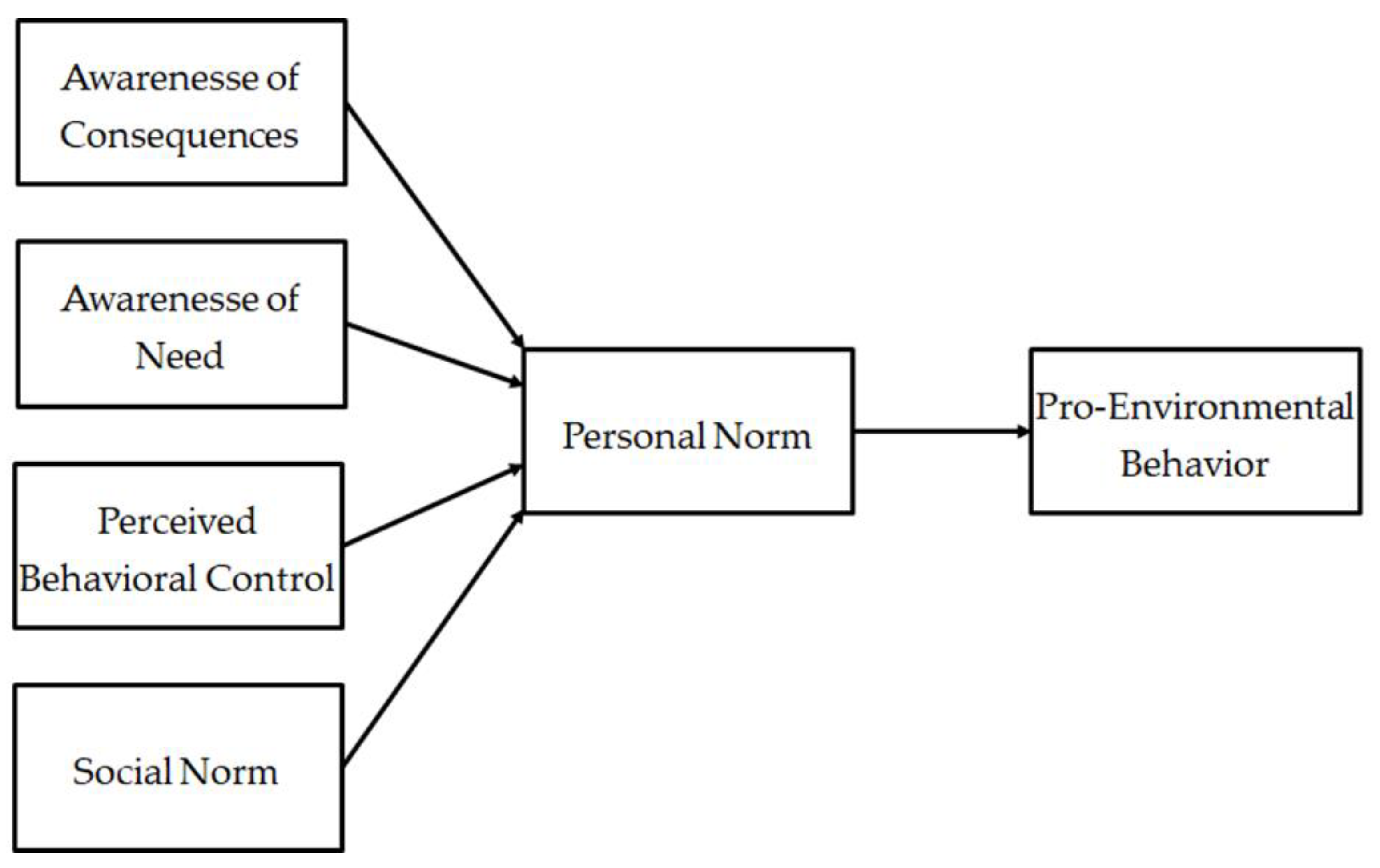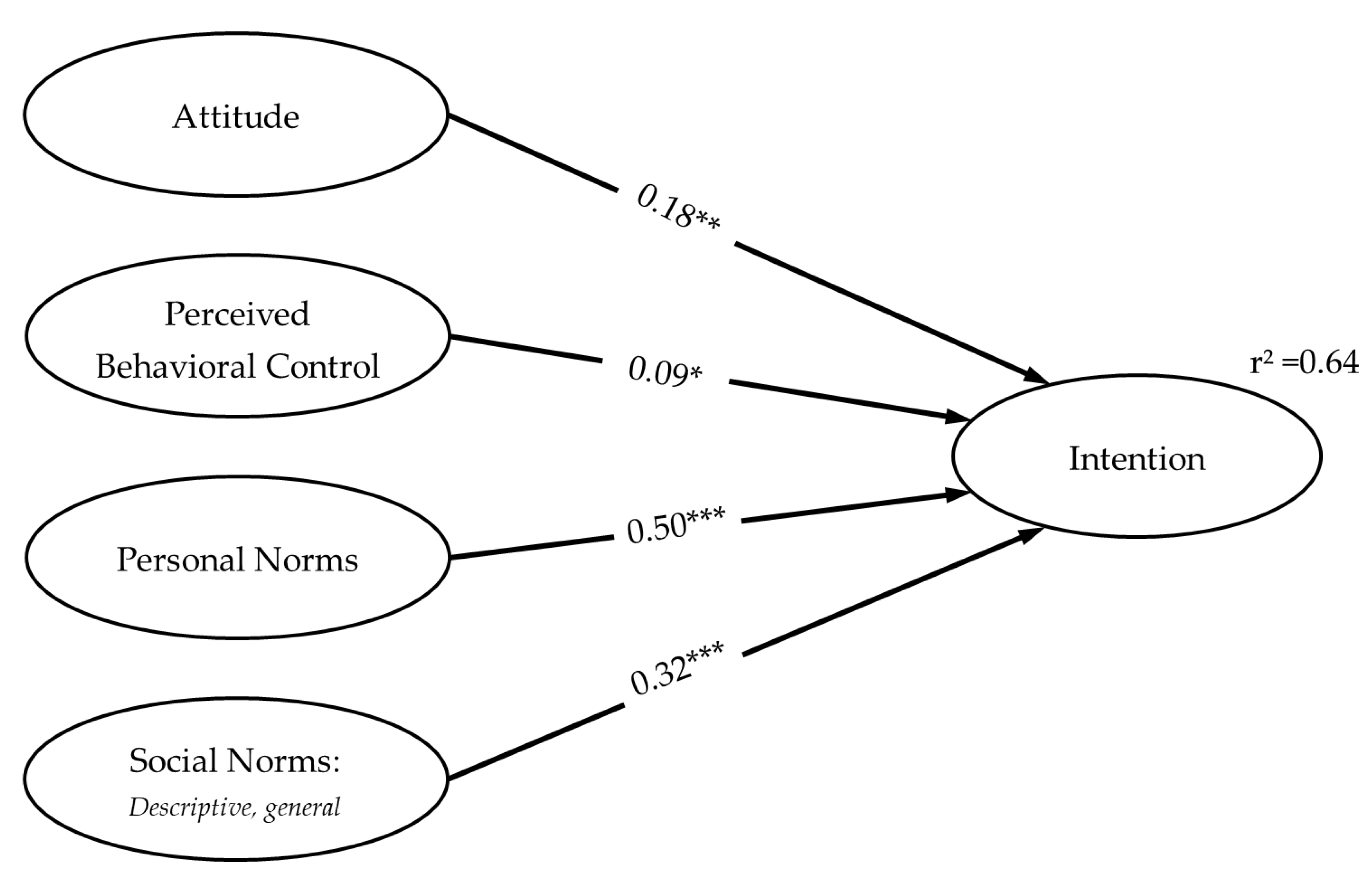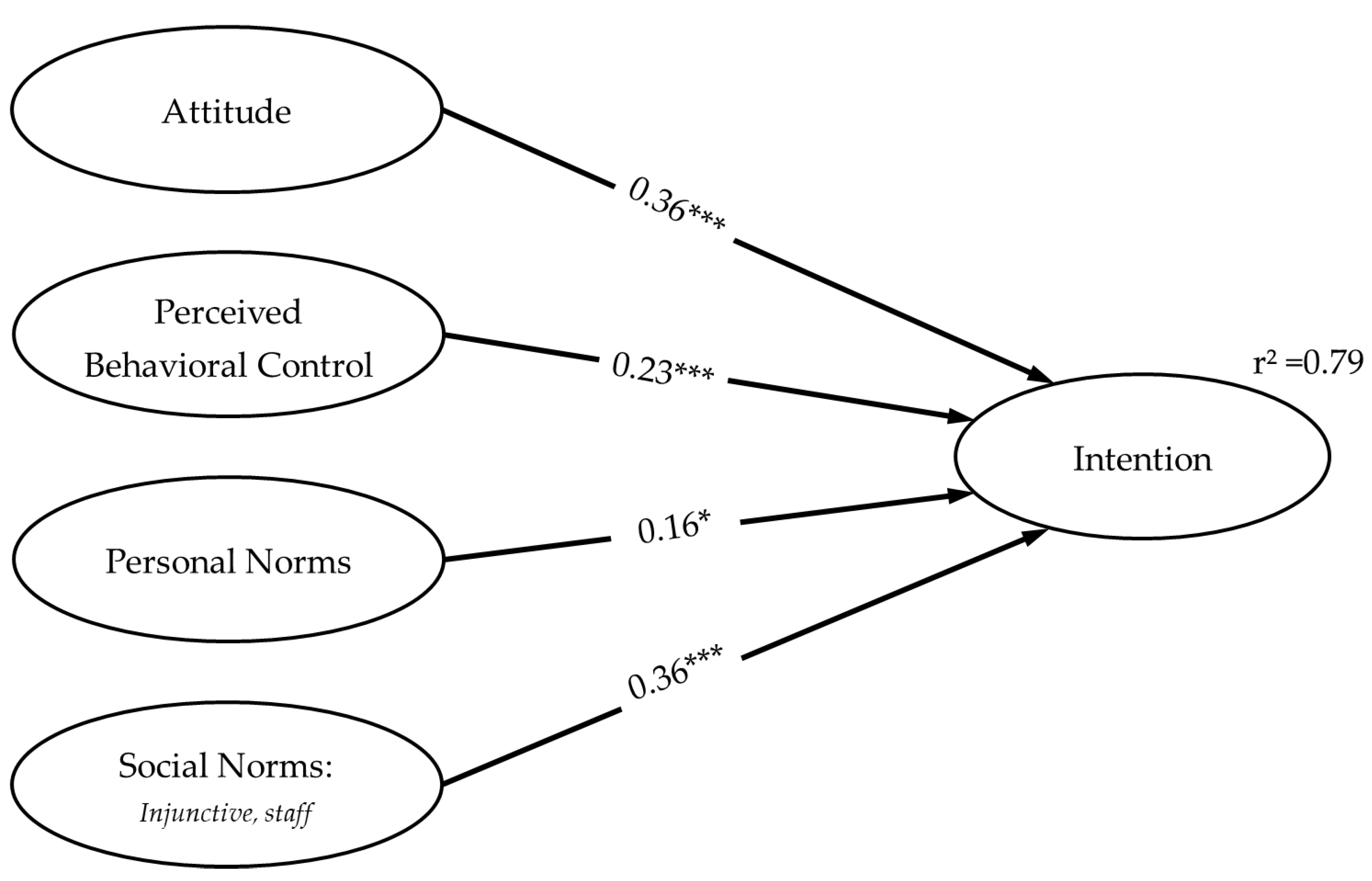Are Professionals Rationals? How Organizations and Households Make E-Car Investments
Abstract
1. Introduction
2. Theory
2.1. Theory of Planned Behavior
2.2. Norm-Activation Model and Value-Belief-Norm Theory
2.3. Integrative Action Models
2.4. The Relevance of Different Types of Social Norms
2.5. Research Agenda and Questions
3. Materials and Methods
3.1. Samples
3.2. Measurements
4. Results and Discussion
4.1. Households
4.2. Organizations
4.3. Difference between Households and Organizations
5. Limitations
6. Conclusions and Policy Implications
Author Contributions
Funding
Institutional Review Board Statement
Informed Consent Statement
Data Availability Statement
Acknowledgments
Conflicts of Interest
References
- Intergovernmental Panel on Climate Change (IPCC). Special Report Global Warming of 1.5 °C. Available online: https://www.ipcc.ch/sr15/ (accessed on 6 February 2020).
- International Energy Agency (IEA). CO2 Emissions Statistics—An Essential Tool for Analysts and Policy Makers. Available online: https://www.iea.org/statistics/co2emissions/ (accessed on 9 August 2019).
- International Energy Agency (IEA). Key World Energy Statistics. 2016. Available online: https://doi.org/10.1787/22202811 (accessed on 23 February 2021).
- Agora Energiewende the Energy Transition in the Power Sector: State of Affairs in 2019. 2020. Available online: https://www.agora-energiewende.de/fileadmin2/Projekte/2019/Jahresauswertung_2019/2020-01-09-Energy-Transition-in-Power-Sector-2019_Summary_Slide-Deck.pdf (accessed on 23 February 2021).
- Center for Climate Protection Survey of Global Activity to Phase Out Internal Combustion Engine Vehicles. Available online: https://theclimatecenter.org/wp-content/uploads/2018/09/Survey-on-Global-Activities-to-Phase-Out-ICE-Vehicles-FINAL.pdf (accessed on 28 October 2019).
- Dietz, T.; Gardner, G.T.; Gilligan, J.; Stern, P.C.; Vandenbergh, M.P. Household actions can provide a behavioral wedge to rapidly reduce US carbon emissions. Proc. Natl. Acad. Sci. USA 2009, 106, 18452–18456. [Google Scholar] [CrossRef]
- Gardner, G.T.; Stern, P.C. Environmental Problems and Human Behavior; Pearson: Boston, MA, USA, 2002. [Google Scholar]
- Abrahamse, W.; Steg, L.; Vlek, C.; Rothengatter, T. The effect of tailored information, goal setting, and tailored feedback on household energy use, energy-related behaviors, and behavioral antecedents. J. Environ. Psychol. 2007, 27, 265–276. [Google Scholar] [CrossRef]
- Kraftfahrt Bundesamt (KBA) Neuzulassungen—Jahresbilanz der Neuzulassungen. 2018. Available online: https://www.kba.de/DE/Statistik/Fahrzeuge/Neuzulassungen/neuzulassungen_node.html (accessed on 23 February 2021).
- Society of Motor Manufacturers and Traders (SMMT). New Car Market Declines in July but pure EV Registrations almost Triple. Available online: https://www.smmt.co.uk/2019/08/new-car-market-declines-in-july-but-pure-ev-registrations-almost-triple/ (accessed on 8 September 2019).
- Rezvani, Z.; Jansson, J.; Bodin, J. Advances in consumer electric vehicle adoption research: A review and research agenda. Transp. Res. Part D Transp. Environ. 2015, 34, 122–136. [Google Scholar] [CrossRef]
- Axsen, J.; Sovacool, B.K. The roles of users in electric, shared and automated mobility transitions. Transp. Res. Part D Transp. Environ. 2019, 71, 1–21. [Google Scholar] [CrossRef]
- Lane, B.; Potter, S. The adoption of cleaner vehicles in the UK: Exploring the consumer attitude–action gap. J. Clean. Prod. 2007, 15, 1085–1092. [Google Scholar] [CrossRef]
- He, X.; Zhan, W. How to activate moral norm to adopt electric vehicles in China? An empirical study based on extended norm activation theory. J. Clean. Prod. 2018, 172, 3546–3556. [Google Scholar] [CrossRef]
- Nordlund, A.; Jansson, J.; Westin, K. Acceptability of electric vehicle aimed measures: Effects of norm activation, perceived justice and effectiveness. Transp. Res. Part A Policy Pract. 2018, 117, 205–213. [Google Scholar] [CrossRef]
- Moons, I.; De Pelsmacker, P. Emotions as determinants of electric car usage intention. J. Mark. Manag. 2012, 28, 195–237. [Google Scholar] [CrossRef]
- Haustein, S.; Jensen, A.F. Factors of electric vehicle adoption: A comparison of conventional and electric car users based on an extended theory of planned behavior. Int. J. Sustain. Transp. 2018, 12, 484–496. [Google Scholar] [CrossRef]
- Nayum, A.; Klöckner, C.A. A comprehensive socio-psychological approach to car type choice. J. Environ. Psychol. 2014, 40, 401–411. [Google Scholar] [CrossRef]
- Klöckner, C.A. The dynamics of purchasing an electric vehicle–A prospective longitudinal study of the decision-making process. Transp. Res. Part F Traffic Psychol. Behav. 2014, 24, 103–116. [Google Scholar] [CrossRef]
- Wang, S.; Fan, J.; Zhao, D.; Yang, S.; Fu, Y. Predicting consumers’ intention to adopt hybrid electric vehicles: Using an extended version of the theory of planned behavior model. Transportation 2014, 43, 123–143. [Google Scholar] [CrossRef]
- Valdez, A.; Potter, S.; Cook, M. The imagined electric vehicle user: Insights from pioneering and prospective buyers in Milton Keynes, United Kingdom. Transp. Res. Part D Transp. Environ. 2019, 71, 85–95. [Google Scholar] [CrossRef]
- Sierzchula, W. Factors influencing fleet manager adoption of electric vehicles. Transp. Res. Part D Transp. Environ. 2014, 31, 126–134. [Google Scholar] [CrossRef]
- Skippon, S.; Chappell, J. Fleets’ motivations for plug-in vehicle adoption and usage: UK case studies. Transp. Res. Part D Transp. Environ. 2019, 71, 67–84. [Google Scholar] [CrossRef]
- Globisch, J. Elektrofahrzeuge in Gewerblichen Fuhrparks: Was Beeinflusst Die Adoption durch Organisationen? Fraunhofer Verlag: Stuttgart, Germany, 2017. [Google Scholar]
- Klöckner, C.A. A comprehensive model of the psychology of environmental behaviour—A meta-analysis. Glob. Environ. Chang. 2013, 23, 1028–1038. [Google Scholar] [CrossRef]
- Bamberg, S.; Möser, G. Twenty years after Hines, Hungerford, and Tomera: A new meta-analysis of psycho-social determinants of pro-environmental behaviour. J. Environ. Psychol. 2007, 27, 14–25. [Google Scholar] [CrossRef]
- Kossmann, B.; von Wangenheim, G.; Gill, B. Wege aus dem Vermieter-Mieter-Dilemma bei der Energetischen Modernisierung: Einsparabhängige Statt Kostenabhängige Refinanzierung; München: Kassel, Germany, 2016. [Google Scholar]
- Moons, I.; De Pelsmacker, P. An extended decomposed theory of planned behaviour to predict the usage intention of the electric car: A multi-group comparison. Sustainability 2015, 7, 6212–6245. [Google Scholar] [CrossRef]
- Ajzen, I. Behavioral Interventions based on the Theory of Planned Behavior: Brief Description of the Theory of Plannes Behaviour. Available online: https://people.umass.edu/aizen/pdf/tpb.intervention.pdf (accessed on 19 March 2019).
- Ajzen, I. The theory of planned behavior. Organizational Behavior and Human Decision Processes 1991, 50, 179–211. [Google Scholar] [CrossRef]
- Nolan, J.M.; Schultz, P.W.; Cialdini, R.B.; Goldstein, N.J.; Griskevicius, V. Normative social influence is underdetected. Personal. Soc. Psychol. Bull. 2008, 34, 913–923. [Google Scholar] [CrossRef]
- Kastner, I.; Wittenberg, I. How Measurements “Affect” the Importance of Social Influences on Household’s Photovoltaic Adoption—A German Case Study. Sustainability 2019, 11, 5175. [Google Scholar] [CrossRef]
- Harland, P.; Staats, H.; Wilke, H.A. Explaining proenvironmental intention and behavior by personal norms and the theory of planned behavior. J. Appl. Soc. Psychol. 1999, 29, 2505–2528. [Google Scholar] [CrossRef]
- Bobeth, S.; Kastner, I. Buying an electric car: A rational choice or a norm-directed behavior? Transp. Res. Part F Traffic Psychol. Behav. 2020, 73, 236–258. [Google Scholar] [CrossRef]
- Bamberg, S.; Hunecke, M.; Blöbaum, A. Social context, personal norms and the use of public transportation: Two field studies. J. Environ. Psychol. 2007, 27, 190–203. [Google Scholar] [CrossRef]
- Schwartz, S.H.; Howard, J.A. A Normative Decision-Making Model of Altruism. In Altruism and Helping Behavior; Rushton, J.P., Sorrentino, R.M., Eds.; Lawrence Erlbaum Associates: Hillsdale, NJ, USA, 1981; pp. 189–211. [Google Scholar]
- Klöckner, C.A. How Powerful are Moral Motivations in Environmental Protection. In Handbook of Moral Motivation; Heinrichs, K., Oser, F., Lovat, T., Eds.; SensePublishers: Rotterdam, The Netherlands, 2013; pp. 447–472. [Google Scholar]
- Stern, P.C. Toward a Coherent Theory of Environmentally Significant Behavior. J. Soc. Issues 2000, 56, 407–424. [Google Scholar] [CrossRef]
- Wolske, K.S.; Stern, P.C.; Dietz, T. Explaining interest in adopting residential solar photovoltaic systems in the United States: Toward an integration of behavioral theories. Energy Res. Soc. Sci. 2017, 25, 134–151. [Google Scholar] [CrossRef]
- Bamberg, S. Changing environmentally harmful behaviors: A stage model of self-regulated behavioral change. J. Environ. Psychol. 2013, 34, 151–159. [Google Scholar] [CrossRef]
- Rogers, E.M. Diffusion of innovations; Free Press: New York, NY, USA, 2010. [Google Scholar]
- Cialdini, R.B. Basic social influence is underestimated. Psychol. Inq. 2005, 16, 158–161. [Google Scholar] [CrossRef]
- de Jesus Pacheco, D.A.; Carla, S.; Jung, C.F.; Ribeiro, J.L.D.; Navas, H.V.G.; Cruz-Machado, V.A. Eco-innovation determinants in manufacturing SMEs: Systematic review and research directions. J. Clean. Prod. 2017, 142, 2277–2287. [Google Scholar] [CrossRef]
- Triguero, A.; Moreno-Mondéjar, L.; Davia, M.A. The influence of energy prices on adoption of clean technologies and recycling: Evidence from European SMEs. Energy Econ. 2014, 46, 246–257. [Google Scholar] [CrossRef]
- Fleiter, T.; Schleich, J.; Ravivanpong, P. Adoption of energy-efficiency measures in SMEs—An empirical analysis based on energy audit data from Germany. Energy Policy 2012, 51, 863–875. [Google Scholar] [CrossRef]
- Bitencourt, C.C.; de Oliveira Santini, F.; Zanandrea, G.; Froehlich, C.; Ladeira, W.J. Empirical generalizations in eco-innovation: A meta-analytic approach. J. Clean. Prod. 2020, 245, 118721. [Google Scholar] [CrossRef]
- Hojnik, J.; Ruzzier, M. What drives eco-innovation? A review of an emerging literature. Environ. Innov. Soc. Transit. 2016, 19, 31–41. [Google Scholar] [CrossRef]
- Maçaneiro, M.B.; da Cunha, S.K.; Balbinot, Z. Drivers of the adoption of eco-innovations in the pulp, paper, and paper products industry in Brazil. Lat. Am. Bus. Rev. 2013, 14, 179–208. [Google Scholar] [CrossRef]
- Bubeck, S.; Tomaschek, J.; Fahl, U. Perspectives of electric mobility: Total cost of ownership of electric vehicles in Germany. Transp. Policy 2016, 50, 63–77. [Google Scholar] [CrossRef]
- Dallinger, D.; Doll, C.; Gnann, T.; Held, M.; Kley, F.; Lerch, C.; Marscheider-Weidemann, F.; Mattes, K.; Peters, A.; Plötz, P. Gesellschaftspolitische Fragestellungen der Elektromobilität; E&B engelhardt und bauer: Karlsruhe, Germany, 2011. [Google Scholar]
- Plötz, P.; Gnann, T.; Ullrich, S.; Haendel, M.; Globisch, J.; Dütschke, E.; Wietschel, M.; Held, M. Elektromobilität in gewerblichen Flotten; Fraunhofer-Institut für System-und Innovationsforschung ISI. Eggenstein: Karslruhe, Germany, 2014. [Google Scholar]
- Institut für Mittelstandsforschung (IFM) KMU in Deutschland gemäß der KMU-Definition der EU-Kommission. Available online: https://www.ifm-bonn.org/fileadmin/data/redaktion/statistik/unternehmensbestand/dokumente/KMU-D_2014-2018_EU-Def.pdf (accessed on 26 January 2021).
- Kaplan, S.; Gruber, J.; Reinthaler, M.; Klauenberg, J. Intentions to introduce electric vehicles in the commercial sector: A model based on the theory of planned behaviour. Res. Transp. Econ. 2016, 55, 12–19. [Google Scholar] [CrossRef]
- Nesbitt, K.; Sperling, D. Fleet purchase behavior: Decision processes and implications for new vehicle technologies and fuels. Transp. Res. Part C Emerg. Technol. 2001, 9, 297–318. [Google Scholar] [CrossRef]
- Bobeth, S.; Matthies, E. New opportunities for electric car adoption: The case of range myths, new forms of subsidies, and social norms. Energy Effic. 2017, 11, 1763–1782. [Google Scholar] [CrossRef]
- Bobeth, S.; Becker, A.; Matthies, E.; Kastner, I. E-mobility adoption in German mobile nursing services: The influence of range and support schemes on investment decisions. in preperation.
- Döring, N.; Bortz, J. Forschungsmethoden und Evaluation in den Sozial- und Humanwissenschaften; Springer: Berlin/Heidelberg, Germany, 2016. [Google Scholar]
- Biresselioglu, M.E.; Kaplan, M.D.; Yilmaz, B.K. Electric mobility in Europe: A comprehensive review of motivators and barriers in decision making processes. Transp. Res. Part A Policy Pract. 2018, 109, 1–13. [Google Scholar] [CrossRef]
- Kastner, I.; Stern, P.C. Examining the decision-making processes behind household energy investments: A review. Energy Res. Soc. Sci. 2015, 10, 72–89. [Google Scholar] [CrossRef]
- Wietschel, M.; Kühnbach, M.; Rüdiger, D. Die Aktuelle Treibhausgasemissionsbilanz von Elektrofahrzeugen in Deutschland; Working Paper Sustainability and Innovation, No. S02/2019; Fraunhofer ISI: Karlsruhe, Germany, 2019; Available online: http://nbn-resolving.de/urn:nbn:de:0011-n-5374326 (accessed on 23 February 2021).
- Hawkins, T.R.; Gausen, O.M.; Strømman, A.H. Environmental impacts of hybrid and electric vehicles—a review. Int. J. Life Cycle Assess. 2012, 17, 997–1014. [Google Scholar] [CrossRef]
- Öko-Institut Kostenrechner für Elektrofahrzeuge. Available online: https://emob-kostenrechner.oeko.de/#/ (accessed on 6 February 2020).





| Study I: Household Members (N = 227) | Study II: Commercial Fleet Owners (N = 101) | General Population in Germany | |
|---|---|---|---|
| Age | |||
| M | 45.6 | 45.9 | 44.4 |
| SD | 11.9 | 8.61 | N/A 1 |
| Gender | |||
| Female | 35.0% | 50.0% | 50.7% |
| Male | 65.0% | 50.0% | 49.4% |
| Highest educational attainment | |||
| No graduation | 0.0% | 0.0% | 4.0% |
| Secondary school | 9.8% | 3.0% | 29.6% |
| Intermediate school | 28.4% | 33.7% | 23.3% |
| Vocational baccalaureate and A level | 22.7% | 46.5% | 32.5% |
| University | 38.7% | 14.9% | 17.6% |
| Other graduation | 0.4% | 2.0% | N/A 1 |
| Study I: Household Members (N = 227) | Study II: Commercial Fleet Owners (N = 101) | |
|---|---|---|
| Investment Intention | ||
| M | 2.62 | 2.62 |
| SD | 1.25 | 1.25 |
| Cronbach’s α/Pearson r | N/A | r = 0.89 |
| Attitude | ||
| M | 3.51 | 3.28 |
| SD | 1.04 | 1.10 |
| Cronbach’s α/Pearson r | α = 0.85 | N/A |
| Perceived behavioral control | ||
| M | 2.64 | 3.13 |
| SD | 1.04 | 1.03 |
| Cronbach’s α/Pearson r | r = 0.28 | N/A |
| Personal ecological norm | ||
| M | 2.91 | 2.30 |
| SD | 1.08 | 1.01 |
| Cronbach’s α/Pearson r | α = 0.83 | r = 0.77 |
| Social norms | ||
| Injunctive norm: General | ||
| M | 2.46 | 2.05 |
| SD | 1.17 | 0.99 |
| Cronbach’s α/Pearson r | α = 0.85 | α = 0.89 |
| Descriptive norm: General | ||
| M | 2.25 | 1.38 |
| SD | 1.08 | 0.87 |
| Cronbach’s α/Pearson r | r = 0.47 | N/A |
| Injunctive norm: Staff | ||
| M | N/A | 2.79 |
| SD | N/A | 1.17 |
| Cronbach’s α/Pearson r | N/A | N/A |
| Descriptive norm: Competitors | ||
| M | N/A | 1.43 |
| SD | N/A | 0.56 |
| Cronbach’s α/Pearson r | N/A | N/A |
| Model 1 | Model 2 | |
|---|---|---|
| Attitudes | 0.11 | 0.18 |
| (0.04) | (0.00) | |
| Perceived Behavioral Control | 0.07 | 0.09 |
| (0.12) | (0.04) | |
| Personal Norms | 0.46 | 0.50 |
| (<0.001) | (<0.001) | |
| Social Norms | ||
| Injunctive Norms | ||
| 0.32 | ||
| Descriptive Norms | (<0.001) | 0.32 |
| (<0.001) | ||
| Adjusted r2 | 0.61 | 0.64 |
| Model 1 | Model 2 | Model 3 | Model 4 | |
|---|---|---|---|---|
| ATT | 0.51 | 0.55 | 0.36 | 0.54 |
| (<0.001) | (<0.001) | (<0.001) | (<0.001) | |
| PBC | 0.21 | 0.19 | 0.23 | 0.19 |
| (0.00) | (0.00) | (<0.001) | (0.00) | |
| PN | 0.19 | 0.24 | 0.16 | 0.26 |
| (0.03) | (0.00) | (0.04) | (0.00) | |
| SN | ||||
| INJ: General | 0.16 | |||
| (0.04) | ||||
| DES: General | 0.10 | |||
| (0.09) | ||||
| INJ: Staff | 0.36 | |||
| (<0.001) | ||||
| DES: Competitors | 0.51 | 0.55 | 0.36 | 0.54 |
| (<0.001) | (<0.001) | (<0.001) | (<0.001) | |
| Adjusted r2 | 0.74 | 0.74 | 0.79 | 0.72 |
Publisher’s Note: MDPI stays neutral with regard to jurisdictional claims in published maps and institutional affiliations. |
© 2021 by the authors. Licensee MDPI, Basel, Switzerland. This article is an open access article distributed under the terms and conditions of the Creative Commons Attribution (CC BY) license (http://creativecommons.org/licenses/by/4.0/).
Share and Cite
Kastner, I.; Becker, A.; Bobeth, S.; Matthies, E. Are Professionals Rationals? How Organizations and Households Make E-Car Investments. Sustainability 2021, 13, 2496. https://doi.org/10.3390/su13052496
Kastner I, Becker A, Bobeth S, Matthies E. Are Professionals Rationals? How Organizations and Households Make E-Car Investments. Sustainability. 2021; 13(5):2496. https://doi.org/10.3390/su13052496
Chicago/Turabian StyleKastner, Ingo, Annalena Becker, Sebastian Bobeth, and Ellen Matthies. 2021. "Are Professionals Rationals? How Organizations and Households Make E-Car Investments" Sustainability 13, no. 5: 2496. https://doi.org/10.3390/su13052496
APA StyleKastner, I., Becker, A., Bobeth, S., & Matthies, E. (2021). Are Professionals Rationals? How Organizations and Households Make E-Car Investments. Sustainability, 13(5), 2496. https://doi.org/10.3390/su13052496







